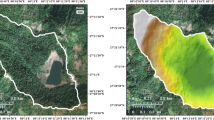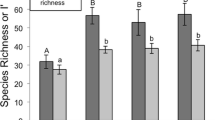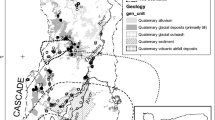Abstract
Mountain wetlands, although limited in their spatial extent, provide many important hydrological and ecological services. There is a need to know existing beaver habitation patterns across mountain wetlands because of emerging interest in using beaver to restore and protect riparian and wetland habitats. However, there exist few inventories of wetlands, or their use as beaver habitat, for any mountain region of North America. We studied the distribution of beaver-impacted mineral wetlands and peatlands in a 7,912 km2 area of the Canadian Rocky Mountains. Using aerial photography and an existing wetland database, we inventoried 529 wetlands at elevations of 1,215 to 2,194 m; peat soils were found at 69 % of the 81 field verified wetlands. Wetland distribution and beaver habitation varied by physiography and jurisdiction. While 75 % of the wetlands identified were located in the foothills region, beaver were twice as likely to inhabit those in the mountain region owing to differences in land use activities and wildlife conservation measures. Wetlands inhabited by beaver had an order of magnitude greater area of open water and 12 times the number of individual open water features than those without. Beaver-enhanced open water extent has far-reaching consequences for wetland ecohydrological and biogeochemical functioning.




Similar content being viewed by others
References
Baldwin J (2013) Problematizing beaver habitat identification models for reintroduction application in the western United States. Yearb Assoc Pac C Geo 75:104–120
Belyea L, Malmer N (2004) Carbon sequestration in peatlands: patterns and mechanisms of response to climate change. Glob Change Biol 10:1042–1052
Bhat MG, Huffaker RG, Lenhart SM (1993) Controlling forest damage by dispersive beaver populations: centralized optimal management strategy. Ecol Appl 3(3):518–530
Bisson PA, Buffington JM, Montgomery DR (2006) Valley segments, stream reaches, and channel units. In: Hauer FR, Lamberti GA (eds) Methods in Stream Ecology, 2nd edn. Elsevier, California, pp 23–49
Blodau C (2002) Carbon cycling in peatlands: a review of processes and controls. Environ Rev 10(2):111–134. doi:10.1139/a02-004
Butler DR (2012) The impact of climate change on zoogeomorphological influence: examples from the Rocky Mountains of the Western U.S.A. Geomorphology 157–158:183–191
Chadde S, Shelly S, Bursik R, Moseley R, Evenden A, Mantas M, Rabe F, Heidel B (1998) Peatlands on national forests of the northern Rocky Mountains: Ecology and conservation. US Forest Service, Rocky Mountain Research Station, General Technical Report RMRS-GTR-11.
Chimner RA, Lemly JM, Cooper DJ (2010) Mountain fen distribution, types and restoration priorities, San Juan Mountains, Colorado. Wetlands 30:763–771. doi:10.1007/s13157-010-0039-5
Conover MR (1994) Perceptions of grass-roots leaders of the agricultural community about wildlife damage on their farms and ranches. Wildl Soc Bull 22(1):94–100
Conover D (2011) The keystone role of beavers in a restored wetland (Ohio). Ecol Restor 29(3):212–213
Cooper DJ, Chimner RA, Merritt DA (2012) Western mountain wetlands. In: Batzer DP, Baldwin AH (eds) Wetland habitats of North America ecology and conservation concerns. University of California Press, California, pp 313–328
Crill PM, Bartlett KB et al (1988) Methane flux from Minnesota peatlands. Glob Biogeochem Cycles 2(4):371–384
Cunningham JM, Calhoun AJK, Glanz WE (2006) Patterns of beaver colonization and wetland change in Acadia National Park. Northeast Nat 13(4):583–596
Gibson PP, Olden JD (2014) Ecology, management and conservation implications of North American beaver (Castor canadensis) in dryland streams. Aquatic Conservation doi:10.1002/aqc.2432 (2014).
Gignac LD, Vitt DH, Zoltai SC, Bayley SE (1991) Bryophyte response surfaces along climatic, chemical, and physical gradients in peatlands of western Canada. Nova Hedwigia 53(1–2):27–71
Gorham E, Lehman C, Dyke A, Janssens J, Dyke L (2007) Temporal and spatial aspects of peatland initiation following deglaciation in North America. Quat Sci Rev 26:300–311
Gunther KA, Biel MJ, Robison HL (1998) Factors influencing the frequency of road-killed wildlife in Yellowstone National Park. Proceedings of the international conference on wildlife, the environment and transportation, Report No. FL-ER-69S58.
Gurnell AM (1998) The hydrogeomorphological effects of beaver dam-building activity. Prog Phys Geogr 22(2):167–189
Halabisky M, Hannam Long AL, Vondrasek C, Moskal M (2013) The sharper image: hyperspatial remote sensing of wetlands. Wetl Scie and Prac 30(2):12–31
Halsey L, Vitt D, Zoltai S (1997) Alberta wetland inventory standards. In Nesby R (ed) Alberta vegetation inventory standards manual, version 2.2, Alberta Environmental Protection, Alberta.
Hebblewhite M, White C et al (2005) Human activity mitigates a trophic cascade caused by wolves. Ecology 86(8):2135–2144
Hood GA, Bayley SE (2008) Beaver (Castor canadensis) mitigate the effects of climate on the area of open water in boreal wetlands in western Canada. Biol Cons 141:556–567
Ise T, Dunn A, Wofsy S, Moorcroft P (2008) High sensitivity of peat decomposition to climate change through water-table feedback. Nat Geosci 1:763–766
Janzen KF, Westbrook CJ (2011) Hyporheic flows along a channelled peatland: influence of beaver dams. Can Water Res J 36(4):331–347
Jarema SI, Samson J, Mcgill BJ, Humphries MM (2009) Variation in abundance across a species’ range predicts climate change responses in the range interior will exceed those at the edge: a case study with North American beaver. Glob Chang Biol 15:508–522
Johnston CA (2012) Beaver wetlands. In: Batzer DP, Baldwin A (eds) Wetland habitats of North America: Ecology and Conservation Concerns. University of California Press, California, pp 161–172
Johnston CA, Naiman RJ (1987) Boundary dynamics at the aquaticterrestrial interface: The influence of beaver and geo-morphology. Landscape Ecol 1:47–57
Johnston C, Naiman R (1990) Aquatic patch creation in relation to beaver population trends. Ecology 71(4):1617–1621
Krankina ON, Pflugmacher D, Friedl M, Cohen WB, Nelson P, Baccini A (2008) Meeting the challenge of mapping peatlands with remotely sensed data. Biogeosciences 5:1809–1820
Lang M, McCarty G (2009) Lidar intensity for improved detection of inundation below the forest canopy. Wetlands 29(4):1166–1178
Maxa M, Bolstad P (2009) Mapping northern wetlands with high resolution satellite images and lidar. Wetlands 29(1):248–260
Messmer T (2000) The emergence of human-wildlife conflict: turning challenges into opportunities. Int Biodeterior Biodegrad 45:97–102
Milbrath J (2013) Land cover change within the peatlands along the Rocky Mountain Front, Montana: 1937–2009. University of Montana, Thesis
Mitchell CC, Niering WA (1993) Vegetation change in a topogenic bog following beaver flooding. Bull Tor Bot Club 120(2):136–147
Moore K (2012) Negotiating the middle ground in a world-system: The Niitsitapi (Blackfoot) and Ktunaxa (Kootenai) in the Northern Rocky Mountain Fur Trade. University of Arizona, MSc Thesis
Pastor J, Bonde J, Johnston C, Naiman R (1993) Markovian analysis of the spatially dependent dynamics of beaver ponds. Lect Mathe iLife Sc 23:5–28
Pollock MM, Beechie TJ et al (2014) Using beaver dams to restore incised streams. Bioscience. doi:10.1093/biosci/biu036
Racine CH, Walters JC (1994) Groundwater-discharge fens in the Tanana lowlands, interior Alaska, U.S.A. Arct Alp Res 26(4):418–426
Ray AM, Rebertus AJ, Ray HL (2001) Macrophyte succession in Minnesota beaver ponds. Can J Bot 79:487–499
Rebertus AJ (1986) Bogs as beaver habitat on north-central Minnesota. Am Midl Nat 116(2):240–245
Roulet N, Crill P, Comer N, Dove A, Boubonniere R (1997) CO2 and CH4 flux between a boreal beaver pond and the atmosphere. J Geophys Res 102(D24):29313–29319
Strack M, Kellner E, Waddington J (2005) Dynamics of biogenic gas bubbles in peat and their effects on peatland biogeochemistry. Glob Biogeochem Cycles 19:1–9
Tardif S, St-Hilaire A, Roy R, Bernier M, Payette S (2009) Statistical properties of hydrographs in minerotrophic fens and small lakes in mid-latitude Quebec, Canada. Can Water Reso J 34(4):365–380
Toop D, de la Cruz NN (2002) Hydrogeology of the Canmore corridor and northwestern Kananaskis Country. Alberta, Alberta Environment, Hydrogeology Section, Edmonton, AB
Törnblom J, Angelstam P, Hartman G, Henrikson L, Sjoberg G (2011) Toward a research agenda for water policy implementation: Knowledge about beaver (Castor fiber) as a tool for water management with a catchment perspective. Balt For 17(1):154–161
Turetsky M, St. Louis V (2006) Disturbance in boreal peatlands. Ecol Stud 188:359–379
Vitt D, Haley L, Thormann M, Martin R (1996) Peatland inventory of Alberta. Alberta Peat Task Force, Network of Centres of Excellence in Sustainable Forest Management, University of Alberta, Alberta.
Walbridge M (1994) Plant community composition and surface water chemistry of fen peatlands in West Virginia's Appalachian plateau. Water Air Soil Pollut 77:247–269
Watters JR, Stanley EH (2007) Stream channels in peatlands: the role of biological processes in controlling channel form. Geomorphology 89:97–110
Westbrook CJ, Cooper DJ, Baker BW (2006) Beaver dams and overbank floods influence groundwater – surface water interactions of a Rocky Mountain riparian area. Water Resources Research 42 doi:10.1029/2005WR004560
Westbrook C, Cooper D, Butler D (2013) Beaver geomorphology and hydrology. In Treatise on Geomorphology – Ecogeomorphology (Butler D, Hupp C, eds.), Elsevier, pp 293–306.
Wieder RK, McCormick AM, Lang GE (1981) Vegetational analysis of Big Run Bog, a nonglaciated Sphagnum bog in West Virginia. Castanea 46(1):16–29
Wolff E, Cooper D, Hobbs N (2007) Hydrologic regime and herbivory stabilize an alternative state in Yellowstone National Park. Ecol Appl 17(6):1572–1587
Woo M-K, Waddington JM (1990) Effects of beaver dams on sub-arctic wetland hydrology. Arctic 43:223–230
Wright J, Flecker A, Jones C (2003) Local vs. landscape controls on plant species richness in beaver meadows. Ecology 84(12):3162–3173
Yavitt J, Lang G, Sexstone A (1990) Methane fluxes in wetland and forest soils, beaver ponds and low-order streams of a temperate forest ecosystem. J Geophys Res 95(D13):22463–22474
Zoltai SC, Siltanen R, Johnson J (2000) A wetland database for the western boreal subarctic and arctic regions of Canada. Natural Resources Canada, Northern Forestry Centre, Information report NOR-X-386
Acknowledgements
We thank Jeff Kardas for his hard work in the field and May Guan and Dhiraj Pradhanaga for their jeep extraction skills. We appreciate the insightful comments provided by Bob Clark, Bruce Baker and two anonymous reviewers. Staff at University of Calgary's Biogeosciences Institute provided much needed logistical support. This research was supported by grants from the Global Institute for Water Security and the Natural Sciences and Engineering Research Council of Canada.
Author information
Authors and Affiliations
Corresponding author
Rights and permissions
About this article
Cite this article
Morrison, A., Westbrook, C.J. & Bedard-Haughn, A. Distribution of Canadian Rocky Mountain Wetlands Impacted by Beaver. Wetlands 35, 95–104 (2015). https://doi.org/10.1007/s13157-014-0595-1
Received:
Accepted:
Published:
Issue Date:
DOI: https://doi.org/10.1007/s13157-014-0595-1




